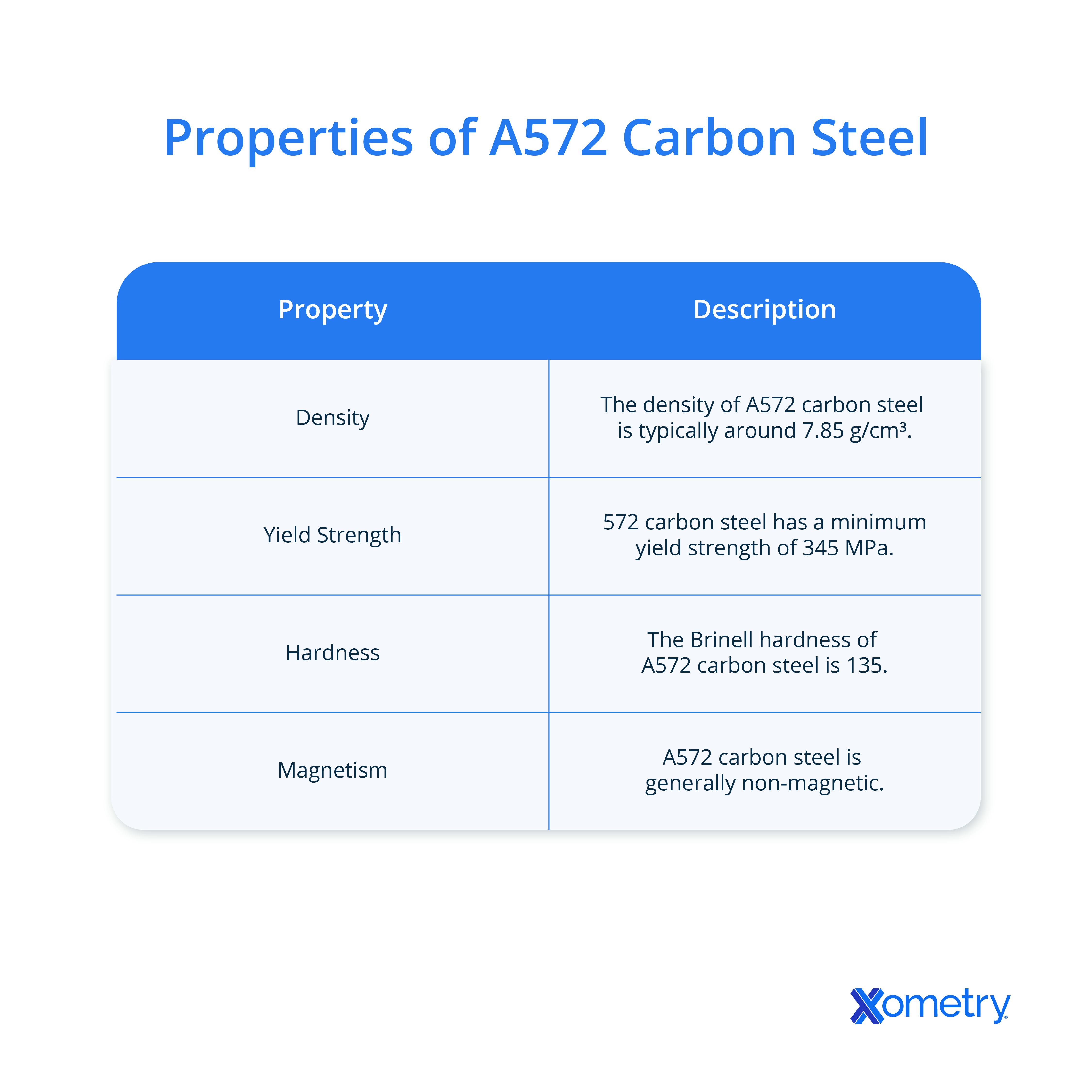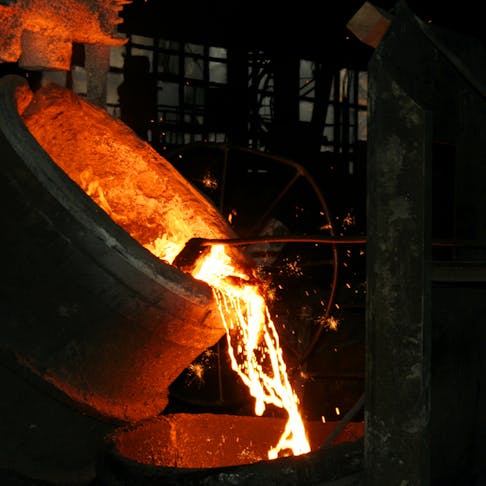A572 carbon steel is a widely used building material known for its superior strength and durability. It is an example of a high-strength low-alloy (HSLA) structural steel standard specification and has many uses across numerous industries. High strength and good weldability are vital for the construction of welded structures such as bridges, buildings, machinery, and machinery parts.
To create A572 carbon steel, iron is combined with trace amounts of carbon, manganese, phosphorus, sulfur, and silicon. The steel becomes stronger, tougher, and more corrosion-resistant after the addition of these alloying components. To illuminate the significance of A572 carbon steel in contemporary engineering and construction, this article examines its composition, characteristics, and uses.
What Is A572 Carbon Steel?
A572 carbon steel, also known as ASTM A572, is a high-strength, low-alloy structural steel that is commonly used in construction and engineering applications. It falls under the category of carbon steel alloys and has exceptional strength and toughness characteristics. Iron (Fe), carbon (C), manganese (Mn), silicon (Si), phosphorus (P), sulfur (S), and small amounts of other elements are typically present in the chemical composition. A572 carbon steel has a crystalline structure. It is suitable for many structural applications due to its strength, durability, and weldability. For more information, see our guide on What is Carbon Steel.
Uses of A572 Carbon Steel
A572 carbon steel is extensively utilized in a variety of industries and applications because of its high strength and adaptability. Some examples of its uses are:
- It is frequently used in the construction of buildings, bridges, and other structural components such as beams, columns, and girders.
- It is utilized in the manufacturing of heavy machinery and equipment, such as cranes, loaders, and excavators. It is also used in the manufacturing of gears, shafts, and parts needing high strength and durability.
- It finds applications in the automotive and transportation industry for manufacturing truck frames, trailers, and railroad cars. It can be found in automotive applications, such as chassis components and suspension systems, due to its strength and impact resistance.
- Infrastructural works like highways, airports, and tunnel construction use A572 carbon steel. It is commonly employed in the construction of bridges due to its high strength and excellent load-bearing capacity.
- It is used for constructing offshore drilling platforms and oil rigs.
How A572 Carbon Steel is Made
Iron ore usually gets melted in a blast furnace to produce A572 carbon steel. Limestone and iron ore are combined, and the mixture is heated in a furnace along with coke (a type of carbon). The iron ore undergoes a chemical reaction as a result of the intense heat, which produces molten iron. The processes of refining eliminate various impurities. Alloying substances like silicon, phosphorus, and manganese are added to give the molten iron the desired properties. After being cast into different shapes, such as plates, bars, or structural sections, the molten steel is cooled and formed into the finished products.
Chemical Composition of A572 Carbon Steel
A572 carbon steel typically contains the following percentages of material shown in Table 1:
| Chemical | Percentage |
|---|---|
Chemical Iron | Percentage 98% |
Chemical Carbon | Percentage 0.21%–0.23% |
Chemical Manganese | Percentage 1.35%–1.65% |
Chemical Silicon | Percentage 0.15%–0.40% |
Chemical Sulfur | Percentage 0.03% |
Chemical Phosphorus | Percentage 0.03% |
Table Credit: https://www.matweb.com/

Machinability Rating of A572 Carbon Steel
A572 carbon steel has a generally good machinability rating. When compared to standard 1112 steel, which has 100% machinability, the machinability of A572 Grade 45 steel is rated at 70%. A material's machinability, which includes aspects like cutting, drilling, and shaping, describes how easily it can be machined. A572 carbon steel's composition, hardness, and microstructure are a few of the factors that affect the material's machinability. Improved machinability can result from lower carbon content and the presence of alloying elements like silicon and manganese. Furthermore, a moderate hardness level can help to lessen tool wear. However, machining A572 carbon steel can be a little trickier than with lower-strength steel due to its high strength and toughness.
Thermal Properties of A572 Carbon Steel
The thermal properties of A572 carbon steel include its thermal conductivity, specific heat capacity, and coefficient of thermal expansion. The thermal conductivity of A572 carbon steel is typically around 45 W/m·K, indicating its ability to conduct heat efficiently. The specific heat capacity, which measures the amount of heat energy required to raise the temperature of a given mass, is 420 J/kg·K. The coefficient of thermal expansion of A572 carbon steel is approximately 10.8–12.5 µm/m·K, indicating that it expands or contracts with temperature changes. These thermal properties are important considerations for applications involving heat transfer and thermal stability.
Common Forms of A572 Carbon Steel Material
A572 carbon steel is available in sheet, bar, and plate forms as described below:
Sheet
A572 carbon steel sheets are commonly used for moderate-strength applications. They offer good formability and weldability. Their composition includes carbon, manganese, phosphorus, sulfur, silicon, and small amounts of alloying elements. The microstructure consists of a mixture of ferrite and pearlite. Sheets are often used in the construction, automotive, and general manufacturing industries.
Bar
High strength and machinability are two qualities that distinguish A572 carbon steel bars. They come in a variety of forms, including round, square, and hexagonal. While the carbon content is slightly higher, the composition is similar to sheets. Ferrite and pearlite make up the majority of the microstructure. Structures, machinery, and production tools all use bars.
Plate
For use in heavy-duty structural applications, A572 carbon steel plates are suitable. They provide outstanding strength and durability and are similar to sheets and bars in composition and microstructure. When high load-bearing capacity and impact resistance are needed, plates are frequently used in general construction, bridge construction, building construction, and machinery.
Hot Rolled
Hot rolled A572 steel undergoes a rolling process at high temperatures, resulting in increased strength and improved mechanical properties. This process alters the microstructure, refining the grain structure and enhancing toughness. Hot-rolled A572 steel is commonly used in structural components, bridges, and machinery that requires high strength and load-bearing capacity.
Annealed
Annealing involves heating A572 steel to a specific temperature and then slowly cooling it, resulting in a softer and more ductile material. Annealed steel is easier to work with, offering improved machinability and formability. It is commonly used in manufacturing processes that require shaping, bending, or forming the material into complex parts or components.
Cold-Drawn
Cold drawn A572 steel is produced by pulling the material through a series of dies at room temperature. This process results in a smoother surface finish and tighter dimensional tolerances compared to hot-rolled or annealed steel. The cold drawing process also increases the strength and hardness of the material, making it suitable for precision components that require high strength and dimensional accuracy. Cold-drawn A572 steel is commonly used in applications such as shafts, pins, bolts, and other critical parts in which precision and strength are paramount.
Advantages of Using A572 Carbon Steel
Using A572 carbon steel has the following benefits:
- The excellent strength characteristics of A572 carbon steel make it possible to build sturdy, long-lasting structures.
- It is easily weldable, making it suitable for fabrication processes and allowing for the efficient joining of components.
- With its availability in different shapes (sheet, bar, and plate) and ability to be hot rolled, annealed, or cold drawn, A572 carbon steel offers versatility for a variety of applications.
- It has good machinability, allowing easier shaping, drilling, and milling operations.
- A572 carbon steel provides a cost-effective solution for various applications due to several reasons. Firstly, it is readily available in the market, ensuring a stable and affordable supply. Secondly, it exhibits excellent strength properties, allowing for the use of smaller sections and the reduction of material requirements. Lastly, its versatility makes it suitable for a wide range of applications, minimizing the need for multiple materials and further enhancing cost-effectiveness.
Disadvantages of Using A572 Carbon Steel
Although A572 carbon steel has many benefits, there are a few drawbacks to take into account:
- A572 carbon steel is not highly resistant to corrosion, especially in corrosive environments. It may require additional protective coatings or regular maintenance to prevent degradation.
- Compared to some other steel alloys, A572 carbon steel may have relatively lower toughness, which could impact its performance in certain high-impact applications.
- It may not achieve the same level of hardness as some other high-strength steels, which could be a consideration for specific applications requiring extreme hardness.
Equivalent Grades of A572 Carbon Steel
Table 3 shows some equivalent grades of A572 carbon steel:
| Country | Equivalent Grade |
|---|---|
Country United States | Equivalent Grade ASTM A572 Grade 50 |
Country European Union | Equivalent Grade S355JR |
Country Germany | Equivalent Grade St52-3 |
Country China | Equivalent Grade Q345B |
Country Japan | Equivalent Grade SM490A |
Country South Korea | Equivalent Grade SS490 |
Country India | Equivalent Grade IS 2062 E350 |
Difference Between A572 Carbon Steel and A514 Steel
The main difference between A572 carbon steel and A514 steel lies in their composition and intended use. A572 is a low-carbon steel with good weldability and moderate strength, commonly used in structural applications. A514 is a high-strength, quenched, and tempered alloy steel primarily used in heavy-duty construction and mining equipment due to its exceptional strength and toughness properties.
Summary
This article presented A572 carbon steel, explained it, and discussed its various applications and properties. To learn more about A572 carbon steel, contact a Xometry representative.
Xometry provides a wide range of manufacturing capabilities and other value-added services for all of your prototyping and production needs. Visit our website to learn more or to request a free, no-obligation quote.
Disclaimer
The content appearing on this webpage is for informational purposes only. Xometry makes no representation or warranty of any kind, be it expressed or implied, as to the accuracy, completeness, or validity of the information. Any performance parameters, geometric tolerances, specific design features, quality and types of materials, or processes should not be inferred to represent what will be delivered by third-party suppliers or manufacturers through Xometry’s network. Buyers seeking quotes for parts are responsible for defining the specific requirements for those parts. Please refer to our terms and conditions for more information.

